External links
- W.T. Stead, "How the Mail Steamer went down in Mid Atlantic. By a Survivor.", published in The Fortnightly Review, volume 53, p. 428 (1890).
"How the Mail Steamer Went Down in Mid Atlantic by a Survivor" is a short story that was published in the 22 March 1886, issue of the Pall Mall Gazette by the English investigative journalist and newspaper editor William Thomas Stead. Stead included this editorial comment: "This is exactly what might take place and will take place if liners are sent to sea short of boats". [1]
Stead was later a First Class passenger on the RMS Titanic, a British ocean liner which collided with an iceberg at the time of her maiden voyage on 14 April 1912, and he was one of approximately 1,500 people who perished in the disaster. Many people believe that this story foreshadows the Titanic tragedy based on its plot and the themes present.
The story centers around an unnamed mail steamer sailing the Atlantic Ocean with passengers, crew, mail and baggage aboard. The main character, a sailor named Thompson, gives an account of his ocean voyage. After a brief scrap with a British Steerage passenger, Thompson goes out on deck later that night and takes a stroll on the Boat Deck. He worries about the number of lifeboats on board and their approximate capacity; about 400 people could be saved on a ship carrying 916 people altogether.
The next day, the steamer collides with a barque in a fog bank. The unnamed sailing ship sinks almost immediately, and the mail steamer begins to list sharply to starboard. Passengers begin to panic wildly, running hysterically about the deck and charging the few boats available. Panicked male passengers force their way into the lifeboats and attempt to lower them on their own, only to be thrown out at gunpoint by sailors and officers. The captain orders Thompson to organize the loading of a lifeboat, putting inside it mostly women, as well as four men to man it. The boat is charged by members of the ship's crew and carelessly lowered.
At this point only one small boat remains, with about 700 people still on board and the steamer listing dangerously. It clears the ship only moments before she sinks with just a few men inside. Thompson and hundreds of others are thrown into the sea. Another boat drifts by, and a man inside cautiously pulls Thompson aboard. Thompson mentions that he and the others in the boats are rescued, and that he is safe at home (albeit, without his kit). Those in the water presumably drown.
The last line of the story gives a disclaimer that the tale is merely an anecdote, employed to describe what would happen if a ship is put to sea without enough lifeboats for all her passengers, officers and crew.
Stead boarded the Titanic for a visit to the United States to take part in a peace congress at Carnegie Hall at the request of U.S. President William Howard Taft. Survivors of the Titanic reported very little about Stead's last hours. [2] He chatted enthusiastically through the 11-course meal that fateful night, telling thrilling tales (including one about the cursed mummy of the British Museum), but then retired to bed at 10:30pm. [2] After the ship struck the iceberg, Stead helped several women and children into the lifeboats, in an act "typical of his generosity, courage, and humanity", and gave his life jacket to another passenger. [3]
A later sighting of Stead, by survivor Philip Mock, has him clinging to a raft with John Jacob Astor IV. "Their feet became frozen," reported Mock, "and they were compelled to release their hold. Both were drowned." [4] William Stead's body was not recovered.
Stead had often claimed that he would die from either lynching or drowning. [3] Stead also published another piece that gained greater significance in light of his fate on the Titanic. In 1892, Stead published a story titled "From the Old World to the New", [5] in which a vessel, the Majestic, rescues survivors of another ship that collided with an iceberg.

John Jacob Astor IV was an American business magnate, real estate developer, investor, writer, lieutenant colonel in the Spanish–American War, and a prominent member of the Astor family. He died in the sinking of the Titanic during the early hours of April 15, 1912. Astor was the richest passenger aboard the RMS Titanic and was thought to be among the richest people in the world at that time, with a net worth of roughly $87 million when he died.
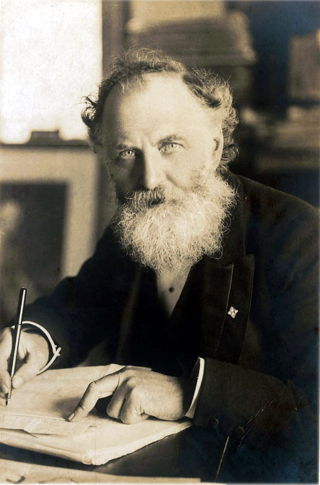
William Thomas Stead was an English newspaper editor who, as a pioneer of investigative journalism, became a controversial figure of the Victorian era. Stead published a series of hugely influential campaigns whilst editor of The Pall Mall Gazette, including his 1885 series of articles, The Maiden Tribute of Modern Babylon. These were written in support of a bill, later dubbed the "Stead Act", that raised the age of consent from 13 to 16.
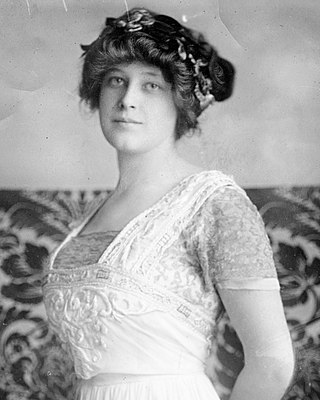
Madeleine Talmage Dick was an American socialite and a survivor of the RMS Titanic. She was the second wife and widow of businessman John Jacob Astor IV.

Violet Constance Jessop was an Argentine ocean liner stewardess and nurse in the early 20th century. Jessop is most well known for having survived the sinking of both the RMS Titanic in 1912 and her sister ship the HMHS Britannic in 1916, as well as having been onboard the eldest of the three sister ships, the RMS Olympic, when it collided with the British warship HMS Hawke in 1911.
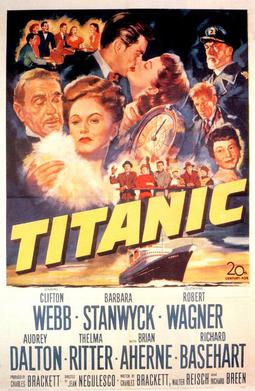
Titanic is a 1953 American drama film directed by Jean Negulesco and starring Clifton Webb and Barbara Stanwyck. It centers on an estranged couple and other fictional passengers on the ill-fated maiden voyage of the RMS Titanic, which took place in April 1912.

Futility is a novella written by Morgan Robertson, first published in 1898. It was revised as The Wreck of the Titan in 1912. It features a fictional British ocean liner named Titan that sinks in the North Atlantic Ocean after striking an iceberg. The Titan and its sinking are famous for similarities to the passenger ship RMS Titanic and its sinking 14 years later. After the sinking of the Titanic the novel was reissued with some changes, particularly to the ship's displacement.

Herbert John "Bert" Pitman MBE was an English Merchant Navy seaman, who was the Third Officer of RMS Titanic when it sank in the North Atlantic Ocean with heavy loss of life after striking an iceberg during the night of 14 April 1912 on its maiden voyage. Pitman was notablely the only member of the command crew of the Titanic who was not a member of the Royal Naval Reserve.

Eleanor Ileen Johnson Shuman was an American telephone operator and one of the last remaining survivors of the sinking of RMS Titanic on April 15, 1912.

John Borland "Jack" Thayer III was a first-class passenger on RMS Titanic who survived after the ship struck an iceberg and sank on April 15, 1912. Aged 17 at the time, he was one of only a handful of passengers to survive jumping into the frigid sea. He later wrote and privately published his recollection of the sinking.

RMS Titanic sank in the early morning hours of 15 April 1912 in the North Atlantic Ocean, four days into her maiden voyage from Southampton to New York City. The largest ocean liner in service at the time, Titanic had an estimated 2,224 people on board when she struck an iceberg at around 23:40 on Sunday, 14 April 1912. Her sinking two hours and forty minutes later at 02:20 ship's time on Monday, 15 April, resulted in the deaths of more than 1,500 people, making it one of the deadliest peacetime maritime disasters in history.
A total of 2,240 people sailed on the maiden voyage of the Titanic, the second of the White Star Line's Olympic-class ocean liners, from Southampton, England, to New York City. Partway through the voyage, the ship struck an iceberg and sank in the early morning of 15 April 1912, resulting in the deaths of 1,517 passengers.
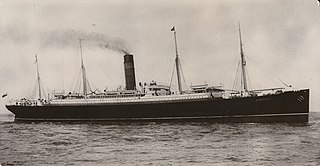
RMS Carpathia was a Cunard Line transatlantic passenger steamship built by Swan Hunter & Wigham Richardson in their shipyard in Wallsend, England.
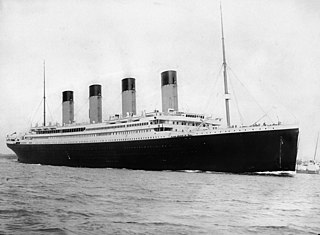
RMS Titanic was a British passenger liner, operated by the White Star Line, that sank in the North Atlantic Ocean on 15 April 1912 after striking an iceberg during her maiden voyage from Southampton, England, to New York City, United States. Of the estimated 2,224 passengers and crew aboard, more than 1,500 died, making it the deadliest sinking of a single ship up to that time. It remains the deadliest peacetime sinking of an ocean liner or cruise ship. The disaster drew public attention, spurred major changes in maritime safety regulations, and inspired many artistic works.

Titanic is a four-part television serial and period drama written by Julian Fellowes. It is based on the passenger liner RMS Titanic, which sank in the North Atlantic Ocean in April 1912 following a collision with an iceberg on her maiden voyage from Southampton to New York City.
Joseph Zupicich was a crewmember on the RMS Carpathia when RMS Titanic survivors boarded the liner after being rescued on April 15, 1912 from lifeboats by the Carpathia crew.

There have been several legends and myths surrounding the RMS Titanic. These have ranged from the myth about the ship having been described as "unsinkable", to the myth concerning the final song played by the ship's orchestra.

Titanic Lifeboat No. 1 was a lifeboat from the steamship Titanic. It was the fifth boat launched to sea, over an hour after the liner collided with an iceberg and began sinking on 14 April 1912. With a capacity of 40 people, it was launched with only 12 aboard, the fewest to escape in any one boat that night.

Lifeboats played a crucial role during the sinking of the Titanic on 14–15 April 1912. The ship had 20 lifeboats that, in total, could accommodate 1,178 people, a little over half of the 2,209 on board the night it sank.

Dickinson H. Bishop was an American businessman who traveled on board the ill-fated maiden voyage of the RMS Titanic while on his honeymoon with bride Helen, née Walton. They both survived the sinking of the Titanic on 15 April 1912.

SS Arctic, an American paddle steamer owned by the Collins Line, sank on September 27, 1854, 50 miles (80 km) off the coast of Newfoundland after a collision with SS Vesta, a much smaller French vessel. Passenger and crew lists indicate that there were probably more than 400 on board; of these, only 88 survived, most of whom were members of the crew. All the women and children on board perished.